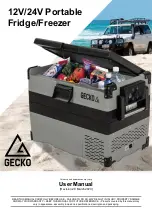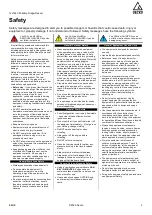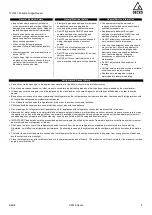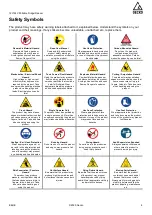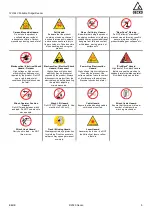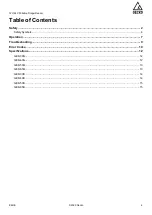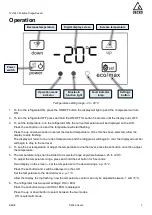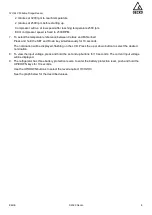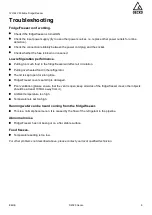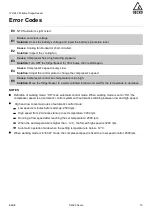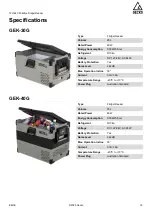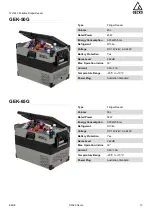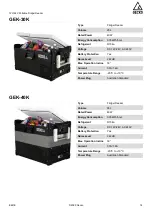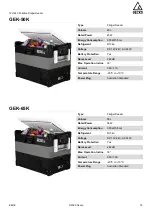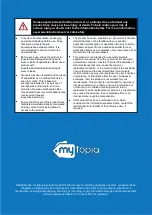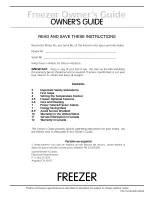
12V/24V Portable Fridge/Freezer
E&OE
© 2020 Gecko
3
General Electrical Safety
•
Inspect electrical equipment, extension
cords, power bars, and electrical fittings for
damage or wear before each use. Repair or
replace damaged equipment immediately.
•
Ensure all power sources conform to
equipment voltage requirements and are
disconnected before connecting or
disconnecting equipment.
•
When wiring electrically powered
equipment, follow all electrical and safety
codes.
•
Wherever possible, use a residual current
device (RCD).
•
High voltage / high current power lines may
be present. Use extreme caution to avoid
contact or interference with power lines.
Electrical shock can be fatal.
General Electrical Safety
•
Electrically grounded equipment must have
an approved cord and plug and be
connected to a grounded electrical outlet.
•
Do NOT bypass the ON/OFF switch and
operate equipment by connecting and
disconnecting the electrical cord.
•
Do NOT use equipment that has exposed
wiring, damaged switches, covers or
guards.
•
Do NOT use electrical equipment in wet
conditions or in damp locations.
•
Do NOT use electrical cords to lift, move or
carry equipment.
•
Do NOT coil or knot electrical cords, and
ensure electrical cords are not trip hazards.
General Service Information
•
The equipment must be serviced or
repaired at authorised service centres by
qualified personnel only.
•
Replacement parts must be original
equipment manufacturer (OEM) to ensure
equipment safety is maintained.
•
Do NOT attempt any maintenance or repair
work not described in this manual.
•
After use, the equipment and components
may still be hot
– allow the equipment to
cool and disconnect spark plugs and/or
electrical power sources and/or batteries
from it before adjusting, changing
accessories or performing repair or
maintenance.
•
Do NOT adjust while the equipment is
running.
•
Perform service related activities in suitable
conditions, such as a workshop.
•
Replace worn, damaged or missing
warning/safety labels immediately.
Refrigerator & Freezer Safety
•
Keep all ventilation openings, in the appliance enclosure or in the build-in structure, clear of obstructions.
•
Do not use mechanical devices or other means to accelerate the defrosting process, other than those recommended by the manufacturer.
•
If the supply cord is damaged, it must be replaced by the manufacturer or its service agent or a similarly qualified person in order to avoid a
hazard.
•
Be cautious not to cause fire when maintaining the refrigerator as the refrigerant and vesicant are burnable. Useless and old refrigerators should
be recycled and disposed by professional companies.
•
Do not discard useless and old refrigerators at will in order to avoid environmental pollution.
•
Children should be supervised to ensure that they will not play with the appliance.
•
Do not damage the refrigerant circuit (applicable only for appliances with refrigeration circuits that are accessible to the user).
•
Never use hot water, solvents, commercial kitchen cleaners, aerosol cleaners, metal polishes, caustic or abrasive cleaners, or scourers to clean
this appliance, as they will damage it. Many commercially available cleaning products and detergents contain solvents and detergents that will
cause damage to your appliance. When cleaning, use only a soft cloth with mild soap and lukewarm water.
•
IMPORTANT! Please make sure the pressurised aerosol containers (identified by the words "flammable" and/or a small flame symbol) must not
be stored inside any refrigerator or freezer.
•
Don't make the inner liner of the refrigerator develop too much frost. Keep the refrigerator door sealed to prevent moisture from entering.
Otherwise, it will affect the refrigeration performance. If defrosting is needed, the system should be shut down and all the frost should be melted
off.
•
The lower the ambient temperature surrounding the refrigerator, the lower its energy consumption. Keep away from strong sourc es of heat and
avoid contact with direct sunlight.
•
Place the refrigerator on a flat, stable surface or it to operate smoothly and efficiently. This product can still work norma lly if the maximum inclined
angle is not more than 30°.

